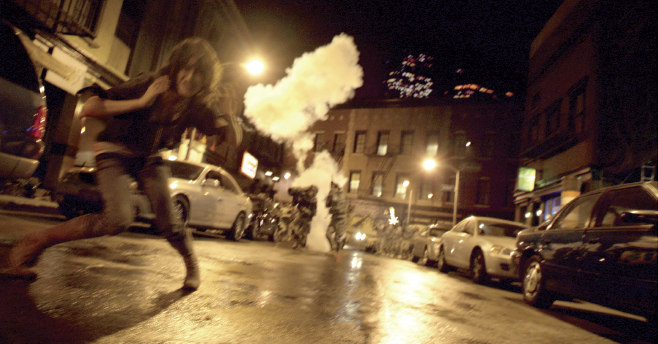MM5-b: Features: Perspective, composition, and editing
As you analyze moving images, think about features such as perspective, composition, and editing. As a viewer of the moving image, you occupy a certain perspective. When viewing an instructional video, you are often the novice or student watching a teacher or trainer who walks viewers through a series of steps or a process for doing something. When you play a video game, you are often one of the characters in the game. Typically when you watch a movie, you are an observer, completely outside the action of the moving images. Perspective influences how viewers perceive what’s happening on-screen.
For an assignment that required students to choose a movie and analyze one production aspect or element, Ellen Yin chose Cloverfield, a moving image that offers viewers an unusual perspective. The following is an excerpt from her essay.
For most movies, the audience is supposed to be unaware of the camera. Viewers are supposed to have an experience of watching the movie and forgetting the existence of a camera filming and a stage, set, crew, and director. When we watch the Harry Potter movies, it’s as if we’re there observing the changes in the characters. When we watch Transformers: Dark of the Moon, it’s as if we’re there witnessing the battles between the Autobots and the Decepticons. The 2008 movie Cloverfield, however, was shot in a way that differs from most major movies; Cloverfield was shot primarily from a first-person perspective. The premise of the movie is that viewers are watching footage captured on a digital video camera found abandoned in New York City after the recorded action. This choice has a huge impact on viewers. Rather than being something we can overlook, the camera becomes a key element in the experience of watching the movie. The viewer feels as if she or he is holding the camera. By offering this first-person, handheld, unpolished perspective, Cloverfield forces viewers to join the main characters in their fight for survival.
Cloverfield is an example of a movie shot from a first-person perspective—making viewers feel as if they are experiencing the action themselves; the camera functions as the viewers’ eyes (see Figure 5-2). This technique is sometimes called a point of view perspective or subjective viewpoint.
Another type of perspective is called third-person view. Video games often use this perspective: The “camera” is above and behind the player character, providing a bird’s-eye view rather than the character’s point of view.
Another quality of moving images to consider is the composition, or the artist’s arrangement of the elements of the image—the people, props, products, and landscape. As a viewer, you might think critically about whether the people in the video seem close to or far away from the camera or close to or far away from other people. Or perhaps there are no people at all. Besides the frame of the movie, TV, or computer screen, can you find other “frames” as well—a window, perhaps, or an archway? Which on-screen elements seem to be emphasized in some way? Also consider what’s not on-screen. Thinking carefully about what the composer may have left out of a scene could prompt an interesting analysis.
Professional film and TV producers use editing—choosing and sequencing shots—to craft a story and elicit a certain response from viewers. Some amateur video is edited (video-editing software can be inexpensive and easy to learn), and some isn’t—usually depending on the composer’s purpose and access to technology. When analyzing moving images, consider how editing affects the pace of the action and the narrative. Does the action proceed quickly from one shot to the next, as in a chase scene in an adventure movie? Or is the action more continuous? Does it proceed more slowly, as in a scene in which a character is shown deep in thought and gazing out a train window?
